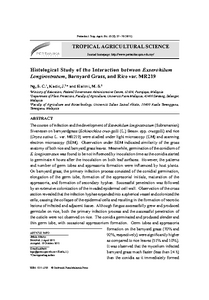Citation
Ng, S. C. and Kadir, Jugah and Sajili, Mohammad Hailmi
(2012)
Histological study of the interaction between Exserohilum Longirostratum, barnyard grass, and rice var. MR219.
Pertanika Journal of Tropical Agricultural Science, 35 (S).
pp. 57-70.
ISSN 1511-3701; ESSN: 2231-8542
Abstract
The course of infection and the development of Exserohilum longirostratum (Subramanian) Sivanesan on barnyardgrass (Echinochloa crus-galli (L.) Beauv. spp. crusgalli) and rice (Oryza sativa L. var. MR219) were studied under light microscopy (LM) and scanning electron microscopy (SEM). Observation under SEM indicated similarity of the gross anatomy of both rice and barnyard grass leaves. Meanwhile, germination of the conidium of E. longirostratun was found to be not influenced by inoculation time as the conidia started to germinate 4 hours after the inoculation on both leaf surfaces. However, the patterns and number of germ tubes and appressoria formation were influenced by host plants. On barnyard grass, the primary infection process consisted of the conidial germination, elongation of the germ tube, formation of the appresorial initials, maturation of the appressoria, and formation of secondary hyphae. Successful penetration was followed by an extensive colonization of the invaded epidermal cell wall. Observation of the cross section revealed that the infection hyphae expanded into a spherical vessel and colonized the cells, causing the collapse of the epidermal cells and resulting in the formation of necrotic lesions of infected and adjacent tissue. Although fungus successfully grew and produced germtube on rice, both the primary infection process and the successful penetration of the cuticle were not observed on rice. The conidia germinated and produced slender and thin germ tube, with occasional appressorium formation. Germ tubes and appressoria formation on the barnyard grass (70% and 92%, respectively) were significantly higher as compared to rice leaves (51% and 10%). It was observed that the mycelium infected barnyard grass much faster (less than 24 h) than the conidia as it immediately formed appressorium without having the need, like the conidia, to germinate first. These results suggest that it may be possible to utilize E. longirostratum as a bioherbicide to control barnyard grass under rice production in Malaysia.
Download File
![[img]](http://psasir.upm.edu.my/19728/1.hassmallThumbnailVersion/82.%20Histological%20Study%20of%20the%20Interaction%20between%20Exserohilum%20Longirostratum%2C%20Barnyard%20Grass%2C%20and%20Rice%20var.%20MR219.pdf)  Preview |
|
PDF
82. Histological Study of the Interaction between Exserohilum Longirostratum, Barnyard Grass, and Rice var. MR219.pdf
Download (2MB)
| Preview
|
|
Additional Metadata
Actions (login required)
 |
View Item |

